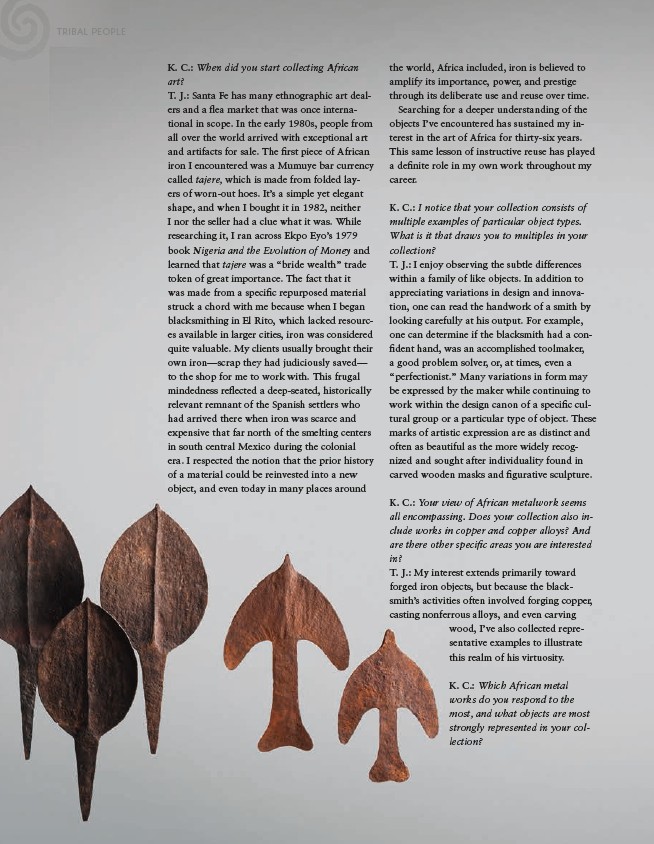
TRIBAL PEOPLE
K. C.: When did you start collecting African
art?
T. J.: Santa Fe has many ethnographic art dealers
and a fl ea market that was once international
in scope. In the early 1980s, people from
all over the world arrived with exceptional art
and artifacts for sale. The fi rst piece of African
iron I encountered was a Mumuye bar currency
called tajere, which is made from folded layers
of worn-out hoes. It’s a simple yet elegant
shape, and when I bought it in 1982, neither
I nor the seller had a clue what it was. While
researching it, I ran across Ekpo Eyo’s 1979
book Nigeria and the Evolution of Money and
learned that tajere was a “bride wealth” trade
token of great importance. The fact that it
was made from a specifi c repurposed material
struck a chord with me because when I began
blacksmithing in El Rito, which lacked resources
available in larger cities, iron was considered
quite valuable. My clients usually brought their
own iron—scrap they had judiciously saved—
to the shop for me to work with. This frugal
mindedness refl ected a deep-seated, historically
relevant remnant of the Spanish settlers who
had arrived there when iron was scarce and
expensive that far north of the smelting centers
in south central Mexico during the colonial
era. I respected the notion that the prior history
of a material could be reinvested into a new
object, and even today in many places around
the world, Africa included, iron is believed to
amplify its importance, power, and prestige
through its deliberate use and reuse over time.
Searching for a deeper understanding of the
objects I’ve encountered has sustained my interest
in the art of Africa for thirty-six years.
This same lesson of instructive reuse has played
a defi nite role in my own work throughout my
career.
K. C.: I notice that your collection consists of
multiple examples of particular object types.
What is it that draws you to multiples in your
collection?
T. J.: I enjoy observing the subtle differences
within a family of like objects. In addition to
appreciating variations in design and innovation,
one can read the handwork of a smith by
looking carefully at his output. For example,
one can determine if the blacksmith had a confi
dent hand, was an accomplished toolmaker,
a good problem solver, or, at times, even a
“perfectionist.” Many variations in form may
be expressed by the maker while continuing to
work within the design canon of a specifi c cultural
group or a particular type of object. These
marks of artistic expression are as distinct and
often as beautiful as the more widely recognized
and sought after individuality found in
carved wooden masks and fi gurative sculpture.
K. C.: Your view of African metalwork seems
all encompassing. Does your collection also include
works in copper and copper alloys? And
are there other specifi c areas you are interested
in?
T. J.: My interest extends primarily toward
forged iron objects, but because the blacksmith’s
activities often involved forging copper,
casting nonferrous alloys, and even carving
wood, I’ve also collected representative
examples to illustrate
this realm of his virtuosity.
K. C.: Which African metal
works do you respond to the
most, and what objects are most
strongly represented in your collection?